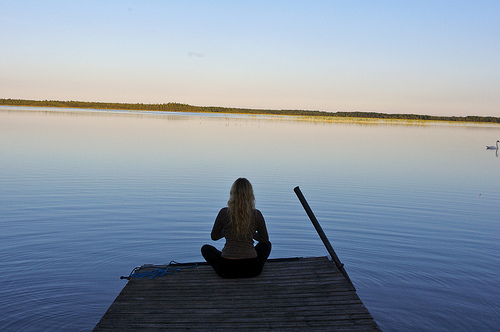Meditation for the Contemporary, Modern Individual
Hectic careers and busy lives require so much commitment and attention, that we can sometimes forget to take care of ourselves. Taking the time to reset your mind and re-calibrate through the use of meditation can improve resilience, mood and sense of well-being.
Meditation is not only for the yogis and spiritually-centered. In fact, I bet you meditate without even knowing it.
The beautiful thing is that it can be done anyplace and anytime… all you need is 10 minutes. In this entry, I will show you how you can use meditation techniques to diffuse stress, re-focus your emotions, find strength in times of fear and even go on a mini mental vacation… wouldn’t that be nice?
Meditation Exercises for Stress Relief and Relaxation
Meditation works by re-focusing your mind on something else, interrupting your current thoughts and allowing relaxation to occur. Each method below is a variation of this principle.
You can focus on breathing, your muscles and sensations in the body, the present moment, a happy place or a controlled sequence of movements. You don’t have to meditate in the stereotypical “Lotus” Position (legs crossed, palms facing up resting on knees). Any position where you feel comfortable will work.
1. Deep Breathing
This exercise can be done at your desk. Sitting comfortably in your chair with your eyes closed, simply take in deep breaths through the nose and exhale slowly through the mouth. Focus intensely on the air entering and exiting your lungs, imagining the air circulating through your body. Think about yourself becoming more and more relaxed with each breath.
2. Progressive Muscle Relaxation
While also sitting comfortable in your chair, this exercise works by tensing and relaxing each muscle in your body, one at a time. Hold the tension for 10 seconds followed by a period of relaxation where you focus on how the muscle feels afterwards. Start with your toes and work your way up to your head. Use deep breathing to help you focus on each muscle becoming more relaxed with each breath. As your body becomes relaxed, so will your mind.
3. Body Scan
Instead of tensing and relaxing your muscles as with the progressive muscle relaxation technique, the body scan requires that you simply focus on the sensations of each part of the body. Start at your toes and work your way up your legs, abdomen and chest, then into your fingertips up to your shoulders, neck and head. Be mindful of any tension you feel.
4. Mindfulness
Mindfulness is a way to distract your mind from thoughts on the past or future. It is a way to bring you to your present reality. This is a great way to diffuse anxiety felt from deadlines, future presentations or past mistakes. One way to do this is to focus on the sensations of your surroundings. Focus on the feeling of the chair, your clothes and shoes, on the ambient noises around you or the temperature. After 5 minutes of this exercise, you should feel more present and more relaxed.
5. Visualization
Visualization works by allowing yourself to focus on appealing scenery of your choice. Sitting relaxed in a chair, close your eyes and practice deep breathing during this exercise. Imagine all the little nuances of your relaxing scene.
As an example, while visualizing yourself stargazing at a cottage, you can also imagine:
- The sensation of the dock at your back, rocking gently with the water
- A warm blanket wrapped around you
- The sensation of cool summer air on your cheeks
- The sounds of loons, crickets, the wind in the trees, and the lake lapping on the shore
- The blackness of the sky contrasting against the milky way
- A mug of hot tea or apple cider in your hand
Or imagine stargazing in the snow like this guy… what would the sensations feel like?
6. Yoga or Repetitive Exercises
Focusing on the flow of the yoga poses and stretches or the repetitive movement of walking combined with deep breathing can help to relieve stress and help you to relax. In addition, these exercises help to release tension, circulate blood, and improve strength, stability and stamina.
Explore these relaxation techniques to find the one that is right for you. You may find that certain techniques are better in certain contexts. Having a daily stress-reduction routine can improve your sense of well-being and resilience to the stressful moments in life.
Photo Credit: Blancalala via Compfight cc

